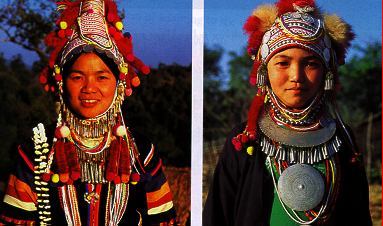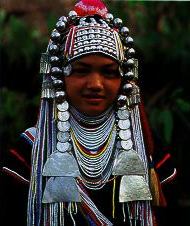
This also Akha tribewoman
|
Beauty takes on exotic new definitions in Northern Thailand, for hill tribe women have a very different concept of what
makes a girl pretty, even from tribe to tribe. Some traits are common to all, such as the lack of makeup, the use of silver ornaments and the general preference for bold, bright color. But no style quite resembles any other other, while within eash style subtle variations express individuality.
|
In addition, hill tribe women in general draw on a staggering array of decorative devices from both the natural world and the modern. These combinations may startle uninitiated visitors, but they soon find that their aesthetic sense, in the tribal environment, quickly accepts the local norms.
And they leave with the feeling that traditional dress makes even tribal "plain Janes" look fetching.
When city women go shopping for clothes and jewelry they purchase ready-made items. Hill women make their own outfits and only buy the components. Some tribal women - the Akha, Hmong, Palaung, and Karen - weave their own cloth as well. Karen weavers lay in decorative patterns while the cloth is still on the loom.
Lisu and Lahu sometimes weave belts and shoulder-bag cloth, but buy the the main costume parts in bolts of different colors. Yao do not weave, but like the Akha and Hmong are meticulous embroiderers.
The Karen are famous as meticulous weavers of uniquely patterned cloth
The Akha, Karen and Palaung grow their own cotton and spin their own thread, whilst the Hmong raise hemp for their cloth. Karen weavers dye the threads first, but Akha and Hmong weave it white and dye it with indigo afterward, when the Hmong also apply designs by batik. Akha and Karen cloth is used for all parts of the costume,
while Hmong cloth is only for the skirts. Once the cloth is dyed the next step is to assemble the costume parts. The applique and patterned stitchwork comes at this point, which can take months of tireless, dedicated work to produce a fully embroidered pair of Yao trousers or an Akha girl's jacket, leggings, skirt-guard and shoulder bag.
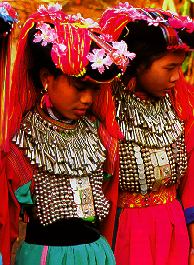
Lisu women buy raw material at a local
market to make their vivid costumes
|
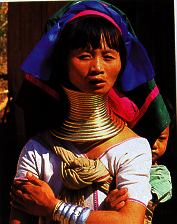
Recycling the past; old colonial British rupees are often melted down to create local jewelry including these Padaung neck rings.
|
Girls of all tribes become adept with spindles, needles and thread at an early age, not from any formal training, but just by copying what their big sisters and mothers are doing. In the most remote villages, where tribes have to make their own clothes because they can't afford to buy any, females of all ages spin thread whenever their hands are free and there's
enough light from the sun, the moon or an oil lamp. And they learn to weave as soon as their legs are long enough to reach the threadles.
Town girls are familiar with a much broader range of beauty models. They've been bombarded all through their formative years with the images of the world's styles and instructed on the ingredients of attractiveness. They are offered the ability to adopt one look for today, another for tomorrow, one for the office, a different one for the big night out, one for the sober presentation, another for the festive occasion.
The tribal exposure to various interpretation or beauty is much circumscribed. No real media influence exists in the tribal girl's world, which is instead heavily saturated with the images of her immediate environment. A tribal girl doesn't want so many "looks." She wants to look like all the other women around her because that has been all she has seen, except for maybe a few hurried glances at the town girl and
other tribalspeople in the plains markets. The only beautiful women she's ever had a good look at have been fellow tribalswomen. I's no wonder they all wear such similar costumes. To look beautiful in the Akha world is to dress in the most carefully crafted Akha costume possible. To be a beautiful Karen girl is to wear the most expertly woven Karen dress that she is capable of creating.
Likewise, on the plains, tribal girls dress up to impress other women more than to attract a male. The big holidays and weddings are times to show off one's skill and compare one's work with that of other. Akha, Hmong and Yao girls will examine ech other's embroidery and if if they see something new will at once try to figure out how it was done. They'll observe what decorations were used and how they were deployed,
inspiring ideas for their next holiday fasion. Lisu girls will count the shoulder stripes on the blouses of their rivals to see whether they have more or less than their own, which is the Lisu girl's measure of applique skill. Karens may do the same with the brass bangles on the arms of fellow villagers.
The city girl has a plethora of jewelry selections. Tribal ornaments are of two kinds: silver items and natural products of their environment. Tribal silversmiths generally fashion the rings, discs, neckrings, chunky bracelets and bangles, from melted down British silver rupees, 92.5 percent pure. These coins are also used as ornaments, especially by the Akha, who attach them to headdresses and stitch them onto jackets and bags.
The Hmong and Yao do the same with French Imdochinese piasters. Even the Lisu are particularly fond of silver ornaments. During festivals girls wear blouses covered front and back with silver studs and pendants, while the occasional girl wears little silver fish in her headdress or suspends a larger one from a thick; silver chain hanging down her back.
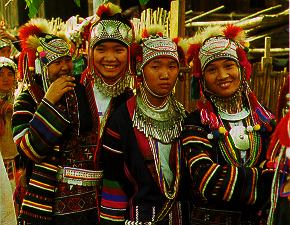
Besides silver jewelry, some of which are family heirlooms, tribals fetch ornament materials from their jungles. Both the Akha and the Karen use Job's tear seeds and the shiny wings of green beetles as decoration. The Karen make beads to be used in necklaces from coconut shell, while the range of Akha embellishments includes animal parts such as gibbon fur and red horsehair tassels. Also,
the Akha are perhaps the only people in the world to make a decorative device from chicken feathers. Women twine the tail feathers around a two-string bow loom, knock them in place with a bobby pin and tie off the tassel at the desired length. They next dye them red and attach them to headdresses, shoulder bags and jackes.
As for hairstyles, most women in the hills keep it in turbans or headdreasses and even those who don't ordinarity, like the younger Lisu and Karen, wrap it up for festivals. The simplest, and even strangest headgear is that worn by the Palaung and the Lahu Sheleh. It is nothing more than a brightly colored hand towel, like the sort you see hanging in your suburban friends' bathrooms. Most other headgear is a version, in one from or another, of the turban.
The most elaborate headpiece, though, is that of the Akha, which varies according to subgroup. The Ulo Akha headdress consists of a bamboo cone, covered in beads, silver studs and seeds, edged in coins (silver rupees for the rich, bath for the poor) topped by several dangling chicken feather tassels and maybe a woolen pom-pom. The Pamee Akha wear a trapezoidal colt cap covered in silver studs with coins on the beaded side flaps and long chains of linked silver rings hanging down each side.
The Lomi Akha wear a round cap covered in silver studs and framed by silver balls, coins and pendants and the married women attach a trapezoidal inscribed plate at the back. By the way, Akha women sleep with their headdress on, though the Ulo women remove the top half first.
The stype of visiting tribals to other traditional villages contrast with that of the welcoming host, and the burden of adapting to the unfamiliar is on the visitors more thn on their hosts, who are, after all, on home ground. But just as the guests usually find it easy to behave respectfully once they discover their hosts behaving likewise, they also have no real trouble in the tribal world. Some adjust so well they even fall in love.
|
Top
|
|
Return to the main page
|


